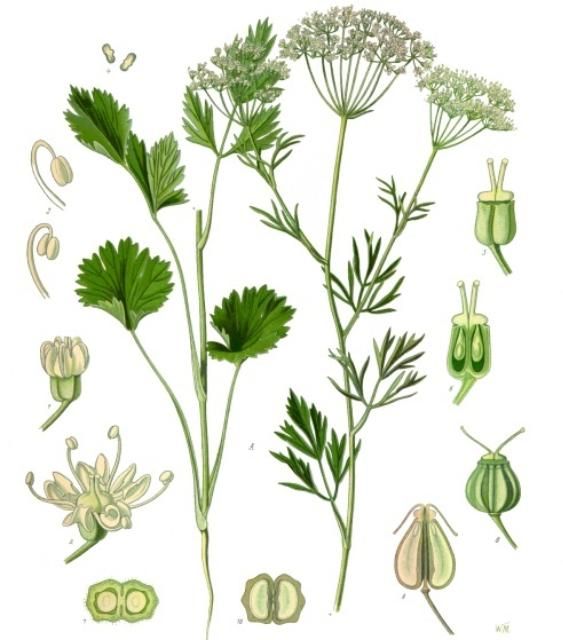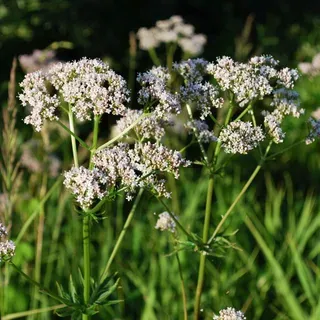Anise—Pimpinella anisum L.1
Anise, or sweet Alice, belongs to the Umbelliferae family. Do not confuse with florence fennel (sweet anise). Anise is an annual herb that reaches a height of about 2 feet. Leaves and seeds are produced in large, loose clusters. The upper leaves are very lacy, while the lower leaves are broader, up to 1 inch wide, resembling parsley. Seeds are oblong, about 1/6 inch long, and curved. Fresh leaves are used for flavoring and garnishing, but the important articles of commerce are the seeds and oil obtained from them.
This annual herb has been widely cultivated throughout the world. The dried fruits, usually called seeds, have been used for centuries for flavoring pastries, candies, and beverages. The oil distilled from the seed is preferred over the seed for flavoring because the seed has an undesirable appearance in some edible products. The oil is also used in medicines, perfumes, soaps, and other toilet articles.

Credit: Franz Eugen Köhler
Culture
The plant requires a light, fertile, sandy loam soil that is well drained. A frost-free season of at least 120 days is required, and uniform rainfall throughout the growing season is essential because the plant is adversely affected by fluctuating soil moisture.
The temperature throughout the growing season should be fairly uniform without excessively hot periods, especially following rainfall. When the seed is near maturity, alternate wet and dry periods cause it to become brown. This reduces seed quality and makes harvesting difficult.
Plant the seed about ½ inch deep in the field in rows 18–30 inches apart at the rate of one to two seeds per inch. At this rate, 5–10 pounds of seed are required to plant one acre. Some European growers broadcast the seed, but if weeds are present at harvest, they will affect the market value of both the seed and the oil. When broadcasting the seed, it is important that the land has been fallow and in clean culture the previous season to eliminate weeds. The harvesting of anise is difficult because the umbels ripen progressively and the seed ripens unevenly within each umbel.
Harvesting
Commercial growers either pull plants out of the ground or cut the tops by hand. The harvested material is tied in bundles and stacked in a conical pile with the fruiting heads toward the center. This is usually done when all the seed in the umbel is still green. The seed then continues to ripen and, when mature, does not discolor and shatter from the plant.
In foreign countries, the seed is usually flailed out, but it can be threshed by machinery. The threshed seed is cleaned and bagged for market. Oil is extracted from the seed by steam distillation. Under favorable conditions, a seed yield of 400 to 600 pounds per acre can be expected.
Potential for Production
The climatic and soil conditions of the central and eastern states offer some possibilities for anise production, but rainy weather at harvest may reduce the yield and quality. Some irrigated sections in California and elsewhere in the West may be adequate for this crop if the temperatures are not too high during the growing and maturing season. The plant also has possibilities as a winter crop in the irrigated valleys of the southwestern states, where it must be planted in late September or early October. Not much is known of its adaptability to Florida conditions since so little is grown here. Some gardeners have grown it successfully in the fall as a garnish green, and it is quite popular as a container-grown plant.



